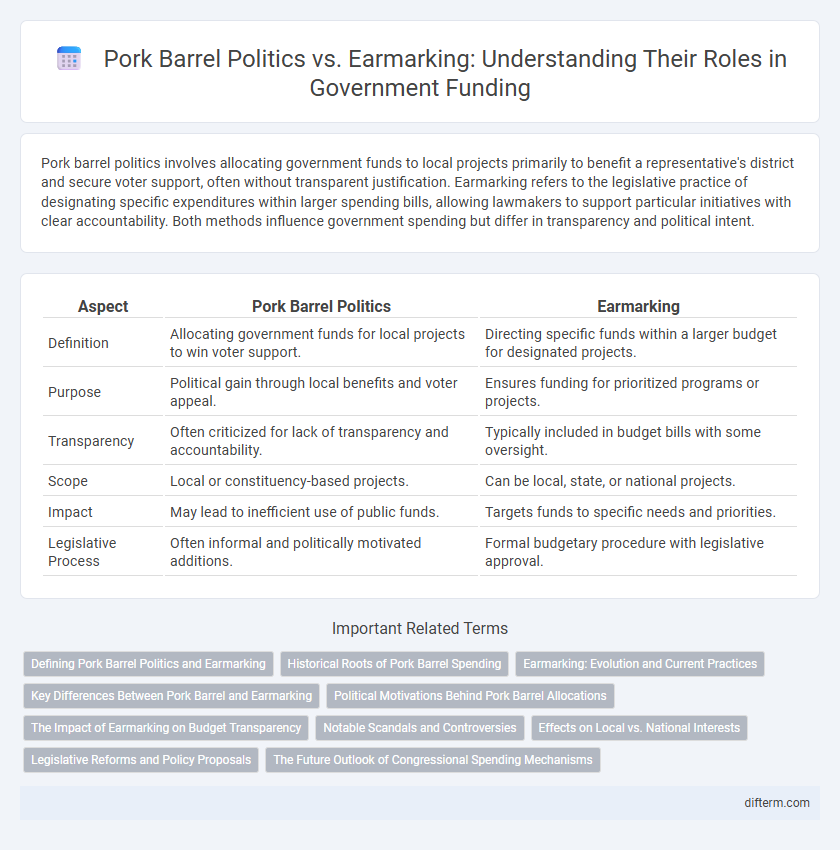Pork barrel politics involves allocating government funds to local projects primarily to benefit a representative's district and secure voter support, often without transparent justification. Earmarking refers to the legislative practice of designating specific expenditures within larger spending bills, allowing lawmakers to support particular initiatives with clear accountability. Both methods influence government spending but differ in transparency and political intent.
Table of Comparison
| Aspect | Pork Barrel Politics | Earmarking |
|---|---|---|
| Definition | Allocating government funds for local projects to win voter support. | Directing specific funds within a larger budget for designated projects. |
| Purpose | Political gain through local benefits and voter appeal. | Ensures funding for prioritized programs or projects. |
| Transparency | Often criticized for lack of transparency and accountability. | Typically included in budget bills with some oversight. |
| Scope | Local or constituency-based projects. | Can be local, state, or national projects. |
| Impact | May lead to inefficient use of public funds. | Targets funds to specific needs and priorities. |
| Legislative Process | Often informal and politically motivated additions. | Formal budgetary procedure with legislative approval. |
Defining Pork Barrel Politics and Earmarking
Pork barrel politics refers to government spending directed to localized projects secured primarily to please legislators' constituents and gain political support, often criticized for promoting inefficiency and favoritism. Earmarking involves the allocation of funds within broader budget bills to specific projects or recipients, typically inserted by lawmakers to address particular local needs while justified as a legislative tool for ensuring targeted investments. Both practices influence federal budget decisions, but earmarking is often framed as a transparent, formalized mechanism, whereas pork barrel politics carries negative connotations of political patronage and misuse of public funds.
Historical Roots of Pork Barrel Spending
Pork barrel spending originated in the early 19th century as legislators sought to secure government funds for localized projects to benefit their constituents, often resulting in politically motivated allocations. Historical analysis reveals that this practice became deeply embedded in American politics during the post-Civil War Reconstruction era when infrastructure and public works were prioritized. Unlike earmarking, which involves more transparent, targeted funding requests, pork barrel politics has historically been associated with opaque deals and patronage systems that influenced congressional power dynamics and resource distribution.
Earmarking: Evolution and Current Practices
Earmarking has evolved from a controversial practice often lumped with pork barrel politics into a more transparent and regulated mechanism for allocating federal funds to specific projects. Modern earmarking emphasizes accountability and strategic prioritization, requiring detailed disclosures and adherence to legislative guidelines to prevent misuse. Current practices focus on balancing regional development needs with national budgetary priorities, promoting efficient and targeted public investment.
Key Differences Between Pork Barrel and Earmarking
Pork barrel politics involves legislators directing government funds to local projects primarily to win voter support, often lacking transparency and scrutiny. Earmarking specifically designates funds within budget bills for particular projects or entities, usually with clearer legislative intent and oversight. Key differences include the scope of funding, transparency levels, and accountability mechanisms, with earmarking typically more structured and regulated compared to the often informal nature of pork barrel spending.
Political Motivations Behind Pork Barrel Allocations
Pork barrel politics involves politicians directing government funds to local projects to secure voter support and reinforce political loyalty, often prioritizing short-term electoral gains over broader public benefits. Earmarking, while sometimes overlapping, typically refers to designated allocations within legislation for specific projects, driven by policy priorities and negotiated interests rather than solely electoral motives. Understanding the political motivations reveals how pork barrel allocations serve as tools for patronage, reinforcing power structures and influencing legislative bargaining processes.
The Impact of Earmarking on Budget Transparency
Earmarking enhances budget transparency by specifying funds for particular projects, allowing stakeholders to track government spending more accurately. Unlike pork barrel politics, which often involves opaque allocation for political gain, earmarking requires clear documentation and justification, promoting accountability in fiscal management. This targeted allocation minimizes misuse of funds and supports informed public scrutiny of government budgets.
Notable Scandals and Controversies
Notable scandals in pork barrel politics include the Philippine Priority Development Assistance Fund (PDAF) scam, where billions of pesos were misappropriated through fake NGO projects, highlighting issues of corruption and misuse of public funds. Earmarking controversies in the United States have involved cases like the Abramoff lobbying scandal, where lawmakers allocated earmarked funds influenced by lobbyists, raising ethical concerns about transparency and accountability. Both practices often lead to public distrust due to opaque fund allocation processes and the potential for abuse by politicians seeking personal or political gain.
Effects on Local vs. National Interests
Pork barrel politics often prioritize local interests by directing government funds to specific districts, which can result in uneven resource distribution and reduced national policy coherence. Earmarking enables targeted funding for projects with broader national significance, balancing local benefits with strategic priorities. The tension between these approaches influences legislative efficiency and equity in public resource allocation across regions.
Legislative Reforms and Policy Proposals
Legislative reforms addressing pork barrel politics emphasize transparency and accountability to reduce misuse of public funds, while policy proposals for earmarking aim to enhance targeted allocation of resources within legal frameworks. Implementing stringent disclosure requirements and participatory budgeting mechanisms can curb patronage and promote equitable development. Reforms also prioritize independent oversight bodies to monitor fund distribution and ensure compliance with democratic principles.
The Future Outlook of Congressional Spending Mechanisms
Congressional spending mechanisms are evolving, with earmarking gaining favor as a more transparent alternative to traditional pork barrel politics, which often faced criticism for fostering wasteful expenditures. The future outlook points toward enhanced accountability and stricter guidelines to ensure earmarks directly support specific, measurable community projects. Digital tools and data analytics are expected to play a significant role in optimizing budget allocation and promoting equitable distribution of federal funds.
pork barrel politics vs earmarking Infographic

 difterm.com
difterm.com